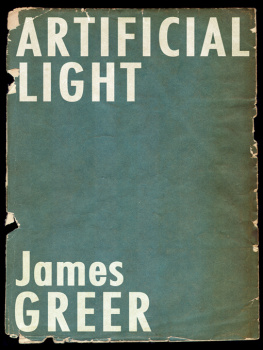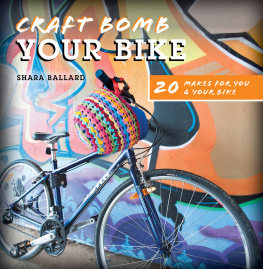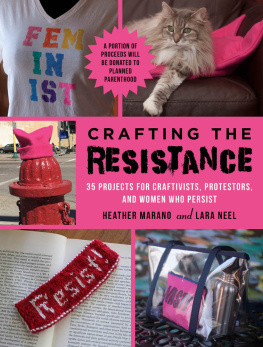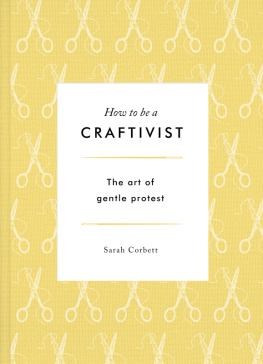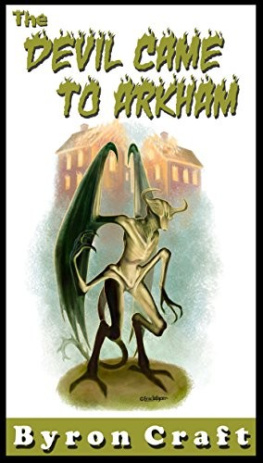craftivism


CRAFTIVISM
Essays copyright 2014 by the Contributors Introduction and interviews copyright 2014 by Betsy Greer
All rights reserved. No part of this book may be reproduced in any part by any meansgraphic, electronic, or mechanicalwithout the prior written permission of the publisher, except by a reviewer, who may use brief excerpts in a review, or in the case of photocopying in Canada, a license from Access Copyright.
ARSENAL PULP PRESS
Suite 202211 East Georgia St.
Vancouver, BC V6A 1Z6
Canada
arsenalpulp.com
Efforts have been made to contact copyright holders wherever possible. The publisher and author welcome correspondence from any copyright holders of material used in this book who have not been contacted.
Design by Gerilee McBride
Editing by Susan Safyan
Library and Archives Canada Cataloguing in Publication:
Craftivism : the art of craft and activism / edited by Betsy Greer.
Includes index.
Issued in print and electronic formats.
ISBN 978-1-55152-535-8 (epub)
1. HandicraftSocial aspects. 2. HandicraftPolitical aspects. 3. Social movements. 4. Social action. 5. Art, Modern21st century.
I. Greer, Betsy, editor of compilation
TT149.C73 2014 745.5 C2014-900268-8
aC2014-900269-6
Efforts have been made to locate copyright holders of source material wherever possible.
The publisher welcomes correspondence from any copyright holders of material used in this book who have not been contacted.
CONTENTS














I n the fall of 2000, I was living in New York City in my aunts amazing Greenwich Village apartment. It was pre-9/11, post-turn-of-the-century, during a hotly contested presidential race between Al Gore and George W. Busha good time to be living in New York. On Halloween night, I walked to the annual Greenwich Village Halloween Parade to watch the bright and colorful costumes of the heavily made-up drag queens and enjoy the general merriment. However, I was most impressed by the literally larger-than-life puppets of both Bush and Gore that deftly paraded down the street, thanks to the help of a puppeteer each. Suddenly, the atmosphere went from boisterous and cheerful to solemn; the election was in just a few days, and everyone (no matter which side they were on) was worried.

After the puppets went past, the parade once again became a loud, happy, celebratory whirl of colors and sparkles and sequins. But there was something in that schism between the loud and the quiet that spoke to me. I didnt put it together until one night later that fall while knitting on my aunts comfy sofa. I began to think about how I could donate the items that I was making to worthy causes and knit things for people in need. And then I remembered the silent but powerful presence of those puppets in the parade. I had always thought that activism had to be loud and in-your-face. Maybe the quietness of the puppets resonated with the quietness of the knitting, but it made me think about quiet activism and wonder how craft could be a part of it. This idea tumbled around in my brain for a while like a load of clothes in the dryer.
Many months later, I mentioned this connection between craft and activism to my knitting circle. One woman, nicknamed Buzz, spoke up and said, You could call it craftivism. I posted this on my online journal, but didnt begin to explore the concept in depth until 2002 when, in a research proposal, I explained that, the creation of things by hand leads to a better understanding of democracy, because it reminds us that we have power. I felt that artists needed a term for crafting that was motivated by social or political activism, and craftivism fit the bill. In March 2003, I bought the domain name craftivism.com, which allowed me to talk about craftivism to others; suddenly it was no longer just a crazy idea in my head. People I didnt know started to write to me about how craft and activism were related in their own lives. Craftivism gave people a quick way to explain what they were doing and a platform from which to create.
The very essence of craftivism lies in creating something that gets people to ask questions; we invite others to join a conversation about the social and political intent of our creations. Unlike more traditional forms of activism, which can be polarizing, there is a back-and-forth in craftivism. As craftivists, we foment dialogue and thus help the world become a better place, albeit on a smaller scale than activists who organize mass demonstrations. To some, our work may seem unimportant, but to me, the small scale of craftivism is vital. It turns us, as well as our work, into vessels of change. As craftivists, we are also permission-givers, helping to breathe life into artistic practices that some people may think are obsolete by showing their relevancy and poignancy. We also demonstrate that the act of making is important; we give other craftivists permission to make boldly, make with the greater good in mind, and make in order to nourish ourselves.
Ive organized this anthology so that it moves from the personal to the political to the level of broader community involvement, in much the same way craftivism came to me. It began inside and, over time, began to grow into something much larger. In the first section, Personal Threads, youll read about the concept of guerrilla kindness and other creative personal approaches to craft. Next, in the Refashioning Craft section, authors and interviewees show how adornment can help us locate our own unique style. The focus is on how we adorn ourselves and our surroundings with what we make and why this is important. With Craft as Political Mouthpiece, the focus shifts away from the self to politics, as we learn how a very tiny knitted mouse turns the tide and how the very act of making can be life-saving under oppressive regimes. In the final section, Activating Communities, we see how craftivism can aid communities and foster both strength and empowerment through creations such as knitted basketball hoops and fabric water droplets. In showing you all these facets of craftivism, it is my hope that you find a way to incorporate craftivism into your own life.
Next page



